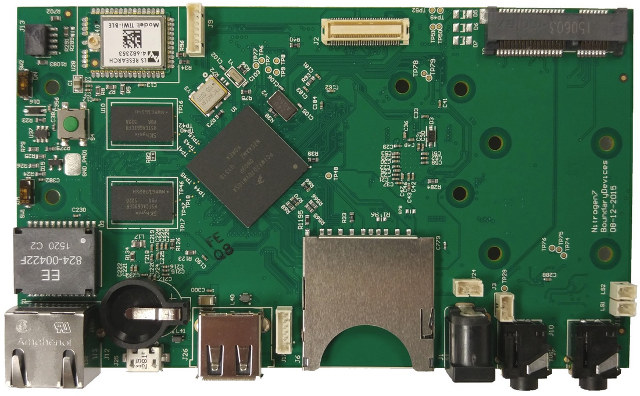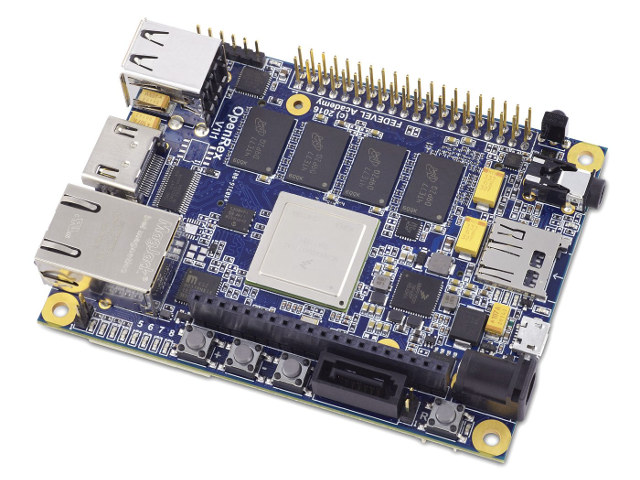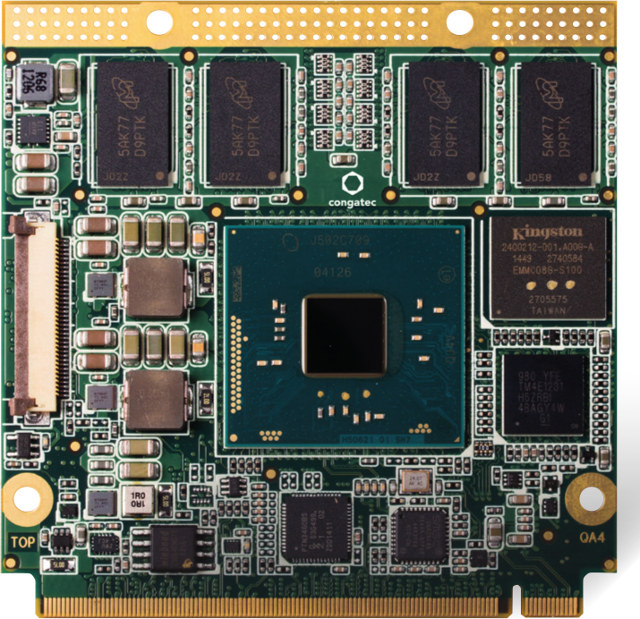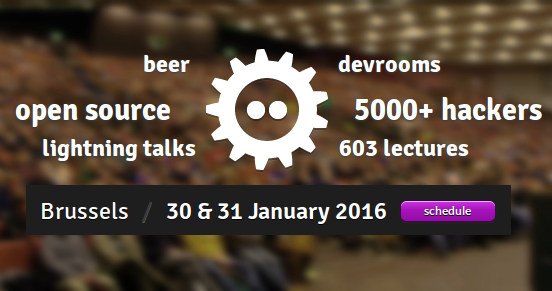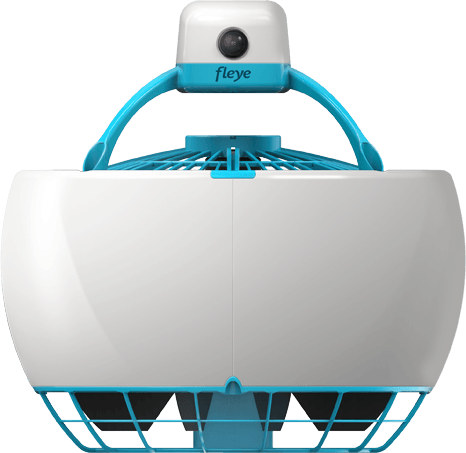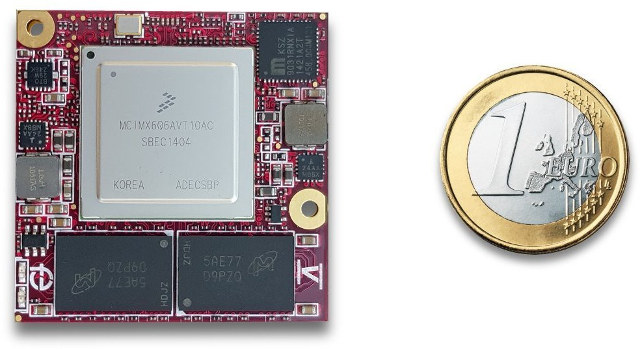While several system-on-modules based on Freescale/NXP i.MX7 processor have been announced such as Compulab CL-SOM-iMX7, or TechNexion PICO-IMX7-EMMC, I had not seen many single board computers or development boards based on the new processor, apart from Freescale i.MX7 96Boards by Arrow Electronics which was scheduled for Q4 2015, but has yet to launch. Boundary Devices Nitrogen7 board is another option that’s available now (in limited quantities) with NXP i.MX7 Cortex A7+Cortex M4 processor, 1GB RAM, 4 to 64GB eMMC, wired and wireless connectivity, and expansion headers. Nitrogen7 board specifications: SoC – Freescale i.MX7 single or dual ARM Cortex-A7 processor @ up to 1GHz + ARM Cortex-M4 MCU + 2D graphics engine System Memory – 1GB DDR3L Storage – 4GB eMMC flash (expandable to 64GB), 2MB Serial NOR Flash, SD card slot Connectivity – 1x 10/100/1Gb Ethernet, WiFi 802.11 a/b/g/n, Bluetooth 4.1 (TiWi-BLE combo module) Display – 24-bit RGB (via expansion […]
OpenRex NXP I.MX6 Open Source Hardware Board Design Files Released
OpenRex is an open source hardware board powered by NXP i.MX6 designed by Fedevel, and the company has announced the release of Altium project design files including both schematics and PCB layout source files, as well as manufacturing documentation. OpenRex board specifications: SoC – NXP i.MX6 processor @ up to 4 cores @ 1.2GHz with 2D and 3D GPU MCU – NXP LPC1345FHN33 ARM Cortex-M3 micro-controller System Memory – DDR3-1066 (533MHz) up to 4GB Storage – SATA, micro SD slot, 1x I2C EEPROM, 1x SPI FLASH Video Output / Display I/F – 1x HDMI up to 2048×1536 resolution, LVDS, parallel RGB display output, touchscreen connector (Optional 4x Analog input) Audio – HDMI output, 3.5mm stereo headphone jack, Camera – 1x Parallel CSI camera (shared with RGB output), 1x MIPI CSI connector compatible with Raspberry Pi (shared with LVDS) Connectivity – 1x 10/100/1000 Mbps Ethernet USB – 2x USB 2.0 host […]
Congatec Introduces Intel Atom x5-E8000 Thin mini-ITX Board, COM Express & QSeven Modules
Following Intel’s announcement of their new Atom x5-E8000 quad core processor with 5W TDP/4W SDP and 7-year availability earlier today, Congatec published a press release for four new platforms based on the processor with conga-QA4 Qseven module, conga-MA4 COM Express Mini & conga-TCA4 COM Express Compact modules, as well as conga-IA4 industrial-grade Thin Mini-ITX board. All four products are actually variation of existing Braswell platforms, but Intel Atom x5-E8000 brings 64-bit computing even cheaper thanks to its $39 recommended customer price. So I’ll just look at the QSeven module specifications in details: SoC – Intel Atom x5-E8000 quad core “Braswell” processor @ 1.04 GHz / 2.00 GHz (Burst) with 2MB L2 cache, and Intel HD Gen8 graphics @ 320 MHz; 5 W TDP. System Memory – Up to 8GB onboard DDR3L with 1600 MT/s On-board Storage – Up to eMMC 4.5.1 onboard flash (optional), 8 MB serial SPI firmware flash […]
Renesas R-Car M2 Porter is a Linux Development Board for Your Car
So far, I always assumed development boards specifically designed for automotive applications would only be available to companies in the car or truck business, but as I wrote about FOSDEM 2016 schedule yesterday, I found out that one of the talk with cover FOSS software stacks that are available for automotive, and usable on hobbyist boards such as Raspberry Pi 2 and Minnowboard Max, but also on Renesas R-Car M2 Porter board specifically designed for automotive infotainment applications. Renesas Port board specifications: SoC – Renesas R-Car M2 dual core ARM Cortex-A15 processor @ 1.5GHz with PowerVR SGX544MP2 GPU, Renesas 2D graphics processor, and Multimedia Engine SH4A @ 780 MHz System Memory – Dual channel 2GB DDR3 Storage – On-board 4 MB SPI, and 64 MB SPI, 1x SATA rev 3.1 connector, 1x SD card slot, and 1x micro SD card slot Video Output / Display I/F – HDMI and LVDS […]
FOSDEM 2016 Schedule – Open Source Hardware and Software Event in Europe
FOSDEM (Free and Open Source Software Developers’ European Meeting) is a 2-day event that usually takes place on the first week-end of February in Brussels, but this year it will be on January 30-31. The event brings thousands of developers, hackers, and other person interested in open source technology who present their projects and share ideas. FOSDEM 2016 schedule is now available, and There will be 557 speakers, 612 events, and 50 tracks this year including 7 main tracks: Distros, Enterprise, Hardware, Communications, Miscellaneous, Office, Systems Administration, and Virtualization. So I’ve had a look at some of the talks, especially out of “Embedded, Mobile and Automotive” and “IoT” devrooms, and prepared my own virtual schedule although I won’t be able to attend. Saturday 10:30 – 10:55 – MIPS, the other side of the embedded by Alexjan Carraturo For many years MIPS processors have been involved in the embedded market, particularly […]
Fleye is a Safe, Robust and Developer Friendly Drone Powered by NXP i.MX6 Processor (Crowdfunding)
In most cases, it’s a pretty bad idea to touch a drone while it’s flying, as you could potentially hurt yourself and others with the blades, so a startup based in Belgium has decided to design a safe drone with the blades hidden under a shell surrounded by protective grids, and with features such as obstacles avoidance. The design also makes the drone sturdier, and less prone to breakage should it fall or hit obstacles. The drone, dubbed Fleye, is based on NXP i.MX6 dual core processor, runs a Linux OS built with the Yocto Project, and the company also plans to provide APIs, and mobile SDKs to allow the developer community to experiment with the drone, and/or create mobile apps. Main hardware features of Fleye drone: SoC – Freescale NXP i.MX6 dual or quad core ARM Cortex A9 processor @ 800 MHz with Vivante GPU System Memory – 512 […]
iMX6 TinyRex Module and Development Board Support HDMI Input in Linux (Video Demo)
A couple of years ago, I wrote about iMX6 Rex open source hardware project combining a Freescale i.MX6 SoM and baseboard that aimed a teaching hardware design (schematics and PCB layout). I had not followed the project very closely since then, until I watched a video showcasing HDMI input capabilities in Linux using the new version of the module and baseboard called i.MX6 TinyRex. i.MX6 Tiny Rex module specifications: SoC – Freescale iMX6 processor up to 1.2GHz and 4 cores System Memory – Up to 4GB DDR3-1066 (533MHz) Storage – EEPROM Connectivity – 10/100/1000 Mbps Ethernet PHY I/Os via 3 board to board connectors: Display / Video Output 1x HDMI (up to QXGA 2048×1536) 1x LVDS (up to WUXGA 1920×1200) 1x 20-bit parallel LCD display (up to WXGA 1366×768) or 1x Video Input (CSI) 1x MIPI DSI differential display output (up to XVGA 1024×768) Video Input 1x 20-bit parallel video input […]
Yocto Project 2.0 “Jethro” Released
The Yocto Project 2.0 was released a few days ago. The framework used to create embedded Linux distributions supports Poky 14 “Jethro” reference distribution by default, but other Linux distributions can also be built with the Yocto Project. Some of the key features and improvements of Yocto Project 2.0 include: Added gcc 5.2 which is now the default compiler (gcc 4.8 and 4.9 are also provided) Updated linux-yocto kernel for qemu* and reference BSPs to version 4.1 Added basic support for Altera Nios II and Adapteva Epiphany Added tune files for Cavium ThunderX, Cavium Octeon, ARM Cortex-A17, Intel Quark X1000, and ARM vfpv3 and vfpv3d16 features Toaster Web UI improvements – Better performance and reliability; simplified setup; user-friendly layout; etc… wic image creation tool version 0.2.0 with bug fixed and new features, such as GPT partition tables, native tools, image compression, etc… Image generation adds support for qcow2, vdi (VirtualBox […]


